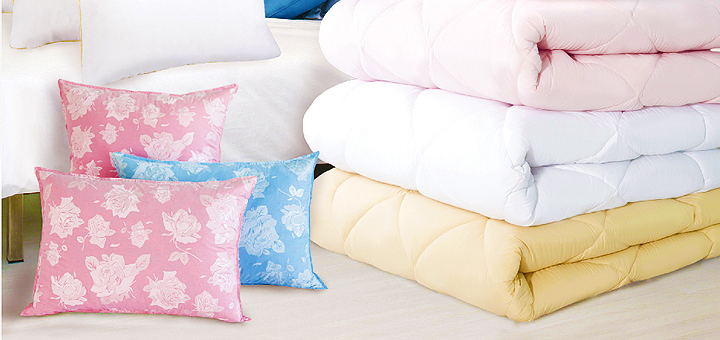
PILLOWS
COVER FABRIC
Cushion cover fabric – Microfiber (polyester), Teak (cotton 100%), Natural Linen. If the photo does not indicate the fabric of the cover, then it means microfiber (polyester).
Types of materials:
Satin is a dense, but at the same time soft to the touch and light material made on the basis of natural cotton.
Jacquard is a fabric that includes natural and synthetic fibers. The positive properties of the material include elasticity, breathability, it is easy to use.
Batiste is a light and thin fabric that holds its shape well. Consists of linen, cotton or synthetic fibers.
Percale is a cotton fabric with excellent wear resistance.
Lyocell is a textile based on cellulose fibers, it retains its shape well and lets air through, it is hygroscopic.
Teak is a fabric made from natural cotton, wear-resistant and dense, characterized by the best down-retaining properties.
FILLERS
The composition of the fillers includes from 0% to 100% natural fibers (the amount depends on the manufacturer and type of pillow), as well as artificial siliconized fibers that fully possess the properties of the corresponding natural filler. Artificial fillers have additional advantages compared to natural ones: they are hypoallergenic, not prone to problems associated with organic matter, and durable.
The main advantages of synthetic materials:
Hypoallergenic – due to the lack of a nutrient medium in synthetic materials, there are no prerequisites for the development of pathogenic microorganisms – viruses, mold, fungi.
Hygiene – polyester fibers do not absorb odors, do not accumulate dust.
Elasticity – the materials do not crumple and do not cake, they have the ability to adapt to the shape of the sleeper’s head, quickly restore their original shape.
Breathability – the hollow structure of synthetic fibers gives the filler the ability to “breathe”, the material does not accumulate moisture and odors.
Thermoregulating ability – in cold weather, the material retains heat for a long time, and in summer days – coolness.
Lightness – with a large volume, synthetic fillers are lightweight.
Easy to care for – products with synthetic filling can be washed in a washing machine, they dry quickly.
Availability – artificial fillers are an order of magnitude lower than natural materials.
CAMEL’S WOOL
Benefits of Camel Hair Pillows
Camel wool is a unique filler that is able to keep warm in winter and give the desired coolness in summer. Its value is not only in naturalness, but also in the fact that wool is collected once every few years.
The distinctive advantage of camel wool pillows lies in the heat-shielding properties, lightness and high hygroscopicity. Such products are not afraid of deformation and quickly return to their original shape after being crushed. Camel wool is very strong, but almost twice as light as sheep. It does not electrify, relieves static stress well, relieves stress and helps to improve the energy background.
Healing properties
This filler is rich in natural animal wax – lanolin, which has healing and antibacterial properties. That is why such pillows are also recommended for preventive and therapeutic purposes for many diseases of the joints and spine. The warming effect of the filler contributes to the expansion of blood vessels, which guarantees the supply of a large amount of oxygen to human organs and tissues.
Camel wool pillows must pass quality control and several stages of dermatological testing.
Positive qualities of natural materials:
light weight;
ecological cleanliness;
ability to absorb moisture;
low thermal conductivity;
healing properties.
Standard bedding sizes for sleeping:
rectangular pillow – 50×70 cm;
square pillow – 70×70 cm;
children’s – 40×60 cm.


